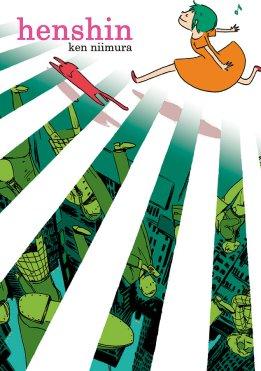 Title: Henshin
Title: Henshin
Genre: Surreal, Drama
Publisher: Shogakukan (JP), Image Comics (US)
Story/Artist: Ken Niimura
Serialized in: Web Ikipara Comic
Translation: Ivy Yukiko Ishihara Oldford
Original Release Date: January 27, 2015
In the back of Henshin, it says the story has “a unique vision of Japanese life.” Scratch the unique part and put in weird because that’s what Henshin is — weird…in a great way.
Telling the stories of multiple types of people — even foreigners — Ken Niimura’s Henshin is a emotional, creative take on daily Japanese life. There are 13 stories comprised of different types of people, from high school students to working adults, to even the author’s stories about a cat and pooping. Yes, pooping. All of them revolve around change, with the henshin name meaning transformation — you might be familiar with that if you’re into sentai — and from little events to significant ones, it changes the lives of these people as they try and live their seemingly normal, mundane lives.
What makes Henshin work is the emphasis that triggers change is subtle or loud, and suitable for each particular story. One example is the very first story, no good, which involves Nat-chan and her uncle. It’s entirely mundane, the two of them meeting up and taking in the day, when he ends up leaving Nat-chan in his car, and, as she is trying to entertain herself while waiting, she discovers a gun in the car compartment. That changes the complexion of the story entirely — it fosters thoughts of, “Is this guy a wanted criminal?”, “what else has he done?” “How is Nat-chan gonna get out of this?” and then her uncle emerges being chased by people with weapons from a theater. The climax of that is insane. It concludes by having them go back to their mundane day.

But the theme of change is real, and for most of the stories it’s just like that — subtle. Another story involving that is a group of people who apparently met up, decided to have a picnic, and planned to kill themselves up in the forest. An old man, who earlier stopped by to get some water, comes back, chides them over not cleaning up, and harasses them just enough that they go back home to Tokyo to try and restart their lives. He then explains that suicide is best meant to be done alone as he kills himself.
This chapter, the first one, and some other stories present what I thought to be more of the theme of Henshin: “People are not who they seem.” You grow up, and eventually you meet people that seem great, but are actually two-faced. You also meet people that seem great, but change over time, sometimes for the worst. Not all of the stories in here are like that — there are positive ones — but there are negative ones, which speaks to how we are as humans. The first chapter sets the tone for what comes up after that, and it continues even towards the end. You’ll get some chapters that are surreal in theme and scope, but overall, you’ll get grounded stories of humans and how they live their lives, either in good or bloody fashion.
Not all of the stories are great. There are 13 of them, so there’s always a shot one or two of them misses the mark, but easily the ones that didn’t keep my interest involved the author, sadly. Generally getting insight would be pretty fun, but aside from one chapter involving him and his efforts to create a manga, the others involved cats, and they weren’t interesting at all. Maybe amusing since it involves the cat making a mess and pooping, but it doesn’t present a theme to me.
But while I might not have liked it, there’s a chance you might like it. There’s enough story to go around where you’ll find one that resonates with you a lot. I found a lot that did for me that I wish I could say more of, but I can’t spoil everything, even the one involving farting. The stories alone is worthy enough as a recommendation. The art, for some chapters, may not be, but it’s not close to a problem. I think that means Henshin is a manga you need to go read now.
 Title: Henshin
Title: Henshin
